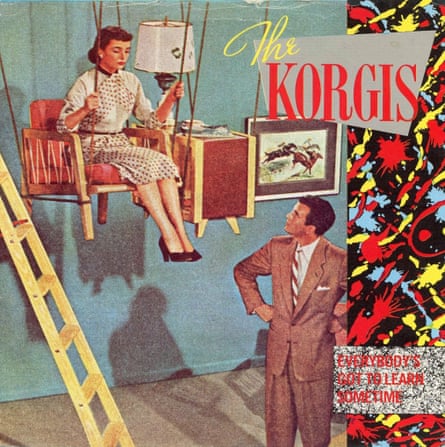James Warren, vocalist/bassist/songwriter
We’d had a Top 20 single in the UK with If I Had You and were recording our second Korgis album, Dumb Waiters. I was living in Bath and had a piano in the flat that I couldn’t really play – I am a guitarist and bass player. But regardless, I battled away at the ivories every day trying to come up with interesting chord sequences.
Basically, I was trying to write a rock ballad that I thought might get us on the radio in the US as I was convinced that the Korgis could have a future there. One Sunday morning, I went to the piano and the first thing I came up with was the opening chords to what became the “change your heart” verse section. This inspired the chorus phrase: “Everybody’s got to learn sometime.” But initially I wasn’t sure what feel the chorus should have. It was our drummer and guitarist Andy Davis who suggested keeping the chorus in a minor key like the verse. Then the song, though simple, felt satisfyingly complete.

The musical vision I had in my mind was Paul McCartney’s demo for The Long and Winding Road where it was just solo voice, piano, bass and drums – which was how we did our original studio demo. I think if we’d stayed with that, we would have ended up with simply a pleasant album track – but we owe it to our producer, David Lord, for seeing the song’s potential. He gave it a more luxurious production with big washes of smooth synthesiser strings and the occasional musical hook played by a sampled Japanese koto.
The finished result sounded gorgeous and we really started to feel we’d come up with something special when friends dropped by the studio to have a listen and were bowled over by this strange and utterly unique creation. We knew then that if ever there was a radio-friendly pop record, this was it!
Even so, we were amazed a couple of months later to see the finished track reach No 18 on the Billboard chart in the US, No 5 in the UK and No 1 in France, Spain and the Netherlands. I think people see it as being a romantic, one-to-one love song, which is a perfectly acceptable interpretation. But for me, it was an attempt at a Zen philosophical statement, inspired by the Buddhist meditation practice I was into at the time.
Since the 1980s, the song has had a life of its own, with more than 50 cover versions to date. My favourite is the dark and brooding versionBeck did for the movie Eternal Sunshine of the Spotless Mind. I have to remind myself that this was something I wrote in 20 minutes on the piano one Sunday morning 45 years ago.
David Lord, producer
We had finished our Dumb Waiters album but felt it was running a bit short and needed another track. James sat down at the piano and said: “Well, I’ve got this song.” He did a verse that was in a plaintive minor key but when he went to the chorus, it changed to a major which gave it a more uplifting mood, rather Beatles-ish sounding. Andy suggested a couple of chord changes to keep it in the same minor mood of the verse.
James had also written a second verse, but nobody, including the record company, liked it. I guess the record company thought if it was going to be a hit, it needed a second verse. They were really pressing us to get one. When we wrote a new one, they didn’t like that either, so we went back to the original. Most people don’t realise it’s the same lyric repeated in the two verses. And then Stuart Gordon added the brilliant violin solo in the middle which was done in one take.
We were lucky because Peter Gabriel, who I’d been working with, lent us new instruments, his cousin having become English distributor for the revolutionary – and expensive – Fairlight computer sampler keyboard. I believe that, at the time, it cost more than the average UK house!
The Japanese-sounding hook between the verses was played on a sampled guzheng [a Chinese plucked zither] on the also very new Synclavier keyboard. If you played a key quickly it did this short-plucked string sound, but if you played a longer note the sample had a bend. So that became the distinctive oriental hook between the verses. Just four short notes and a long one with the bend. There have been some really some great covers of the song. I especially love the Zucchero one.
Source: theguardian.com

















